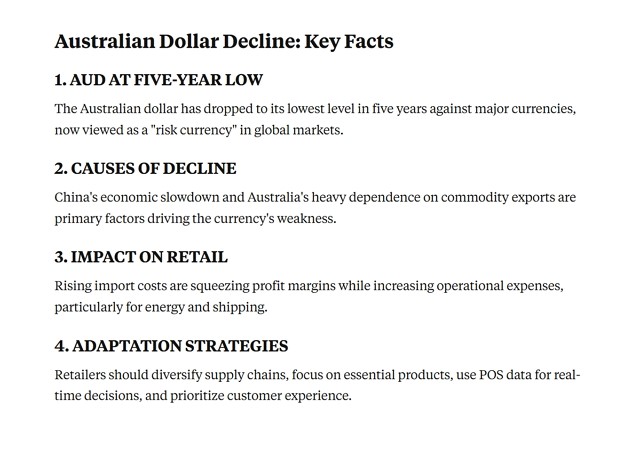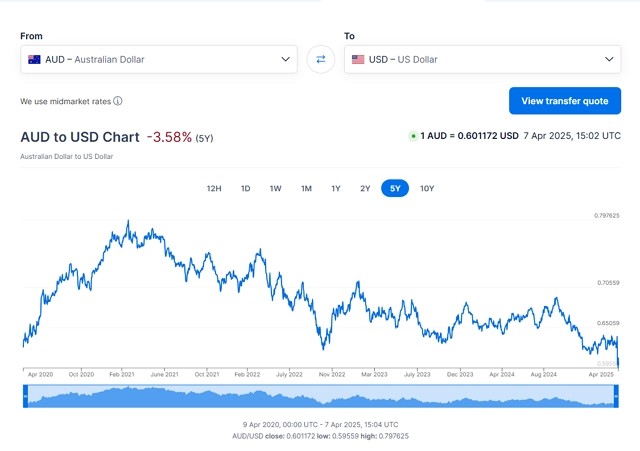Australian Dollar Crisis: Practical Tips for Retailers

The Australian dollar (AUD) is in a decline against its major currencies. It presents a significant economic challenge. Some people attribute this problem to external factors, such as trade tensions with other countries. However, the real causes are deeply rooted in Australia’s financial situation.
Here is a table to show this.

Just looking at the table, you can see that it's not Trump, as we received only the minimum 10%, and yet almost everyone, including those who received more, is doing better than we are: Japan, 24%; China 54%; and India, 27%. None have seen their currencies drop as much as ours.
The Australian dollar is now at a five-year low. It has been going down for years, and the forecast for it is not good.

We are facing significant challenges for retailers since nearly everything is imported. Let's now examine Australia's Retail Outlook.
Retailers must adapt
Why Is the Australian Dollar Dropping?
That's a good question I wish would be asked more often now.
Our economy
This decline is compounded by external factors such as global trade dynamics and Australia's reliance on commodity exports. It has not been pretty for quite a while, and now our currency is viewed as a “risk currency.”
China’s Economic Slowdown
As Australia’s largest trading partner, China’s weaker economy and economic uncertainty are dragging down the AUD.
Commodity Dependence
Australia relies heavily on exporting commodities. Much of this is in uncertainty.
Unemployment
While unemployment rates are currently low, job availability in high-paying, export-oriented sectors, such as mining, is shrinking. This trend could lead to problems.
To many of you, this will affect your customers' spending habits.
How Does a Weaker AUD Affect Retailers?
Fewer tourists
Many of my customers tell me how they miss the Chinese tourists. Tourism is vital to us.
Rising Business Expenses
As we all sell products sourced internationally, you’re likely to be hit by higher wholesale prices soon. A weaker AUD makes imports more expensive.
These increased costs often lead to higher retail prices and/or a squeezing of profit margins.
Increased Operational Expenses
Beyond inventory costs, other business expenses will rise:
####Energy Prices In addition to the rising electricity prices we now face, Coal remains a dominant source of electricity generation in Australia. Since coal prices are set in US dollars, a weaker AUD directly increases electricity expenses for businesses.
Shipping Costs
Importing goods becomes more expensive as freight costs are typically calculated in foreign currencies, often the US dollar.
What Can Retailers Do to Adapt?
Consumer Spending Slowdown
With inflation now eating into household budgets, shoppers have prioritised essentials over discretionary purchases. This trend is if you sell non-essential items, such as fashion or gifts. I suggest stocking items that are necessities. Children are not being affected by this trend.
Diversify Your Supply Chain**
Relying on a single supplier is risky when currencies fluctuate; local goods and local suppliers might reduce reliance on imports. Shop around; different suppliers in different countries are affected differently. For example, a New Zealand supplier is only marginally affected, whereas a Japanese supplier would be significantly impacted.
Use your POS System
As prices and the economy change, the quickest and best way to assess your business and its current status is through your POS System. It will tell you trends, what is working and what is not working. What you need is actual data in real time.
Conclusion
Retailers in Australia faced a challenging period.
We need to focus on the customer experience.
The future belongs to those retailers who adapt.
Written by:

Bernard Zimmermann is the founding director at POS Solutions, a leading point-of-sale system company with 45 years of industry experience. He consults to various organisations, from small businesses to large retailers and government institutions. Bernard is passionate about helping companies optimise their operations through innovative POS technology and enabling seamless customer experiences through effective software solutions.



